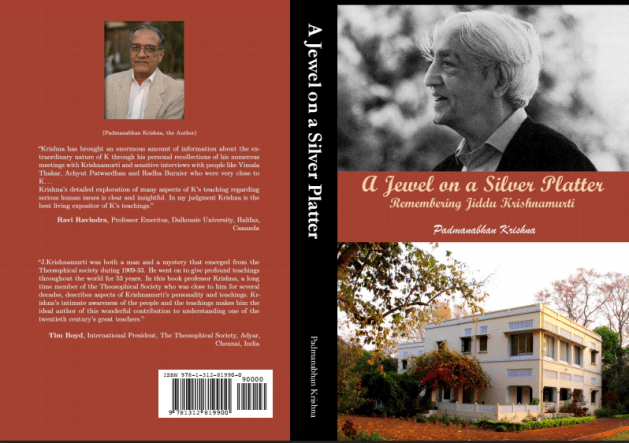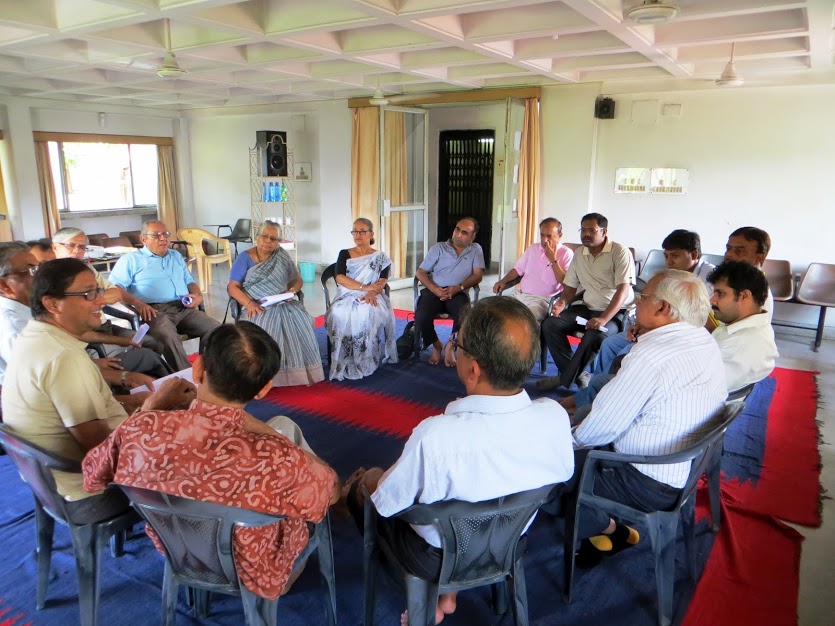

“We must have the capacity to think together. The capacity comes naturally and inevitably if one sees the importance and the necessity in a corrupting world, that to think together does not imply agreement or disagreement, but putting aside one’s own particular prejudice, opinion, judgment and having thus the capacity to think together. Because when we think together there is no division, you are not thinking separately from the speaker.”
Jiddu Krishnamurti, Second public talk, Saanen 1979
The following extract is from the book ‘A Jewel on a Silver Platter’ by Padmanabhan Krishna. The extract is taken from Chapter 15: The Art of Dialogue.
The Art of Dialogue
‘The dictionary defines ‘Dialogue’ as a conversation between two or more people and also as an exchange of opinion or ideas. Krishnamurti gave to it a much deeper meaning and pointed out its importance as a means of religious inquiry into Truth, which he posited as the unknown. He distinguished between the knowledge of the truth and the realization of the truth and used dialogue as a means of enabling the latter.
The sacred books of all religions contain descriptions of the truth that was realized by great religious seers but those descriptions do not reveal the truth to us when we read them. They may point to the truth, give us an idea about it and create an intellectual understanding of it but that is not the same as the realization of the truth. Krishnamurti attempted to bridge that gap through the mode of what he called a dialogue.
A dialogue is very different from what we call discussion or debate. A discussion is usually between people who have adopted definite points of view and who wish to convince each other or compare their outlooks. They are usually committed to a certain opinion, ideology, religious belief, political system or nationality and argue from that particular point of view. Most of our university seminars and symposia as well as international diplomatic exchanges are of such a nature. They begin with knowledge, encourage an exchange of ideas and end in more knowledge and more ideas. Since the whole exercise is confined to the field of ideas and knowledge, it does not lead to the realization of a deeper truth.
On the other hand, a dialogue as a mode of religious inquiry begins with not knowing. The participants know that they do not know the truth, posit it as the unknown and are eager to investigate together in order to discover it. In not knowing, not identifying themselves with any point of view, not trying to convince each other of anything, they are together and not pitted against each other. It is as if they are on the same side of the table and the truth is on the other side.
It is our knowledge, our beliefs, our points of view that divide us. If we set them aside, we can begin to explore like two friends, deeply interested in examining any issue in life and coming to a deeper understanding of it. The truth may reveal itself in the very process of exploring the question, rather than trying to quickly answer it. An answer given by a mind that has not deeply examined and understood all that is involved in the issue is merely a superficial opinion and therefore of little value for a seeker of truth.
Knowing this, the mind is not interested in forming opinions in a dialogue and coming to conclusions. Nor is it competing with others in arriving at the truth first since it is not ambitious and not seeking satisfaction, fame or reputation. It is a mind that is inquiring for the love of understanding, not for a result or a conclusion.
A mind in dialogue doubts every opinion, is skeptical of every conclusion because it is not interested in a verbal answer. It is seeking to go beyond the word and have a deep insight into reality. It is looking for the perception of facts and for a holistic understanding of the issue, not merely a method for solving a problem. Since one is looking for a deep and direct perception of the truth and not merely the transference of knowledge, there is no hierarchy in a dialogue. There is no division of the teacher and the taught – the one who knows and the one who does not know.
A dialogue begins with observation and aims at discerning what is true from what is false. Since the inquiry is not based on knowledge, it is not in the nature of a transfer of ideas from one who knows to another who does not know. It is rather a joint exploration into ‘what is’, conducted with utter humility by friends who know that they do not know but wish to understand and come upon the truth.’
